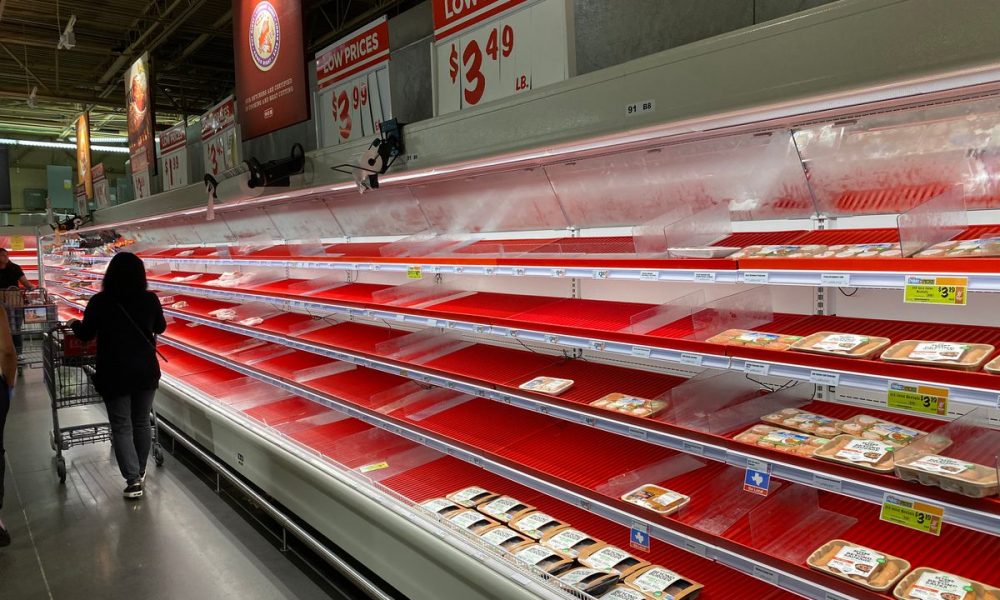We have too much milk, may not have enough meat and could eventually run short on soup.
Let’s just say America’s food supply chain is getting out of whack due to the coronavirus pandemic.
The sudden shift from restaurant dining to at-home eating, coupled with panic buying at grocery stores, is causing major disruption in the manufacturing, distribution and sales of food products. Dairy farmers are dumping excess raw milk, while meat companies are scrambling to meet demand.
Though experts say the food supply chain has performed admirably so far – most factories are still operating and many are doing so at full blast – industry watchers are getting concerned about supplies of beef, poultry and pork as the COVID-19 crisis continues.
After Smithfield Foods on Sunday announced the indefinite closure of its pork processing plant in Sioux Falls, South Dakota, due to an outbreak among its employees, CEO Kenneth Sullivan issued a warning about the state of the nation’s meat supply chain.
Some food companies – such as Conagra Brands, which makes Duncan Hines desserts, Slim Jim jerky and Hunt’s ketchup – are temporarily reducing varieties to focus on items that are in high demand.
Discounts are also disappearing as retailers and manufacturers try to shore up supplies.
“Typically, you run promotions or discounts if you want to see heightened demand on your products or get heightened awareness out, but (not) right now,” said Arun Sundaram, a stock analyst for CFRA Research who tracks food companies.
In the wake of panic buying, supplies of products like soup and pasta “are still catching up,” said Mike Duffy, CEO of C&S Wholesale Grocers, a wholesale grocery supply company with more than 15,000 employees. He estimated that retailers have only about half of the pasta and soups they would typically carry.
And the demand for soup in the spring could have a ripple effect later this year, Duffy said.
“This is the time of year where the soup manufacturers will build inventories for the fall and winter season, and we’re using a lot of that inventory right now just to keep shelves stocked,” he said.
In a twist, though, some other types of products are readily available.
Supplies of raw milk, which is processed into drinkable dairy milk, greatly exceed retail demand due in large part to the collapse of sit-down dining at restaurants and the closure of schools. Now, dairy farmers are dumping excess milk that they can’t sell to processors.
Duffy said the food supply chain is “responding, but it’s stressed.”
Much of the industry’s focus right now is on ensuring the continuous supply of fresh meat, particularly after Smithfield on Wednesday announced that it would temporarily close its dry sausage plant in Cudahy, Wisconsin, and its ham plant in Martin City, Missouri.
“Right now, we’re OK” on meat supplies, “but it’s something we watch, frankly, daily,” Duffy said.
One of the reasons that plant shutdowns are particularly disruptive for the meat industry is they’re typically very large due to the labor-intensive methods of processing meat, such as picking out bones by hand. With 3,700 employees, the Smithfield plant in Sioux Falls usually represents about 4% to 5% of U.S. pork production, or about 18 million servings per day.
Workers at meat processing plants are especially at risk of contracting the coronavirus because they’re often positioned close to one another, experts say.
Several other meat processing plants around the U.S. also have closed with many workers infected, including Tyson Foods’ plant in Columbus Junction, Iowa, where two workers died, and JBS USA’s Greeley, Colorado, factory, which also has had two deaths.
“In other types of food processing facilities, they tend to be more machine operators, so people are not in as close proximity and not as susceptible,” said Rick Williams, a partner at Battle Creek, Michigan-based JPG Resources, a food and beverage operations consultancy.
Deanna Darrah, of Randolph, Ohio, said she has tried repeatedly to find ground beef in the last month and was met with empty shelves.
“We’ve been eating more vegan meat,” said Darrah, who is a dietary cook at a nursing home. “The organic stuff is not flying off the shelves in northern Ohio.”
In the poultry industry, a sickened workforce is threatening to create an imbalance between the number of chickens on the farm and the number processed into meat for sale at the store.
About 2 million chickens owned by a company on the Delmarva Peninsula, which includes southern Delaware, the Eastern Shore of Maryland and Eastern Shore of Virginia, will be killed at the farms where they were raised, according to Delmarva Poultry Industry Inc. But their meat will not make it to market due to an insufficient number of workers to keep up with production.
John Campbell has had difficulty finding chicken and eggs in Yankton, South Dakota, at both Walmart and Hy-Vee.
“There’s just a giant empty area where chicken used to be,” Campbell said. “They have some chicken wings, but I don’t see chicken breast or chicken thighs. And eggs are hit or miss. Sometimes they’ll have them and other times they are completely sold out.”
Why is milk being dumped
With milk, it’s a different story. The sudden closure of schools and restaurants has thrust farmers into crisis mode. Milk consumed there, including milk used to make cheese and butter at restaurants, is suddenly going to waste.
Brian Rexing, a dairy farmer in Indiana’s southwest corner, said he was forced to dispose of nearly 30,000 gallons of milk in the fields on his farm last week. There was nowhere for the milk to go.
“When you can’t finish it and get it to market and see it in consumers’ hands, that’s tough, that’s our livelihood,” said Rexing, who owns New Generation Dairy in Owensville, Indiana.
For more than a week, Golden E Dairy farm near West Bend, Wisconsin, has been dumping about 25,000 gallons of milk a day because processing plants, full to the brim, will not take it.
“People were saying things like ‘how could I sleep at night,’ and that I should be ashamed of myself,” Elbe said. “Some people thought it was only happening on this farm. But it’s all across the country. There are a lot of farms doing this now.”
Yet he can’t donate milk to charities because, straight from the farm, it’s unpasteurized and unbottled. State law, for one thing, would prohibit that.
“We can’t just pull up in front of a food pantry with a 7,000-gallon tank and say, ‘here you go, get your jugs out and we will fill them.’ But some people don’t understand,” Elbe said.
Jim Mulhern, CEO of the National Milk Producers Association, which represents dairy farmers and co-ops, said farmers have been hit hard despite “strong” retail demand.
“It is that displacement of product that has created problems throughout the supply chain. It all backs up,” he said.
What many Americans don’t realize, however, is that milk dumping is not unusual, as the dairy business has been in crisis mode for years with consumers drinking less milk.
“It’s not uncommon to have wastage and the stories of milk being poured off,” JPG Resources partner Rifle Hughes said. “That actually happens all time.”
In a way, the milk industry operates like the automotive industry, which relies on just-in-time supply of parts to assemble into finished vehicles. With one big exception.
“While we have just-in-time manufacturing for a normal market, we don’t have the ability to turn off that spigot when there’s a disruption,” Mulhern said. “You can’t just shut those cows off to stop the milk from coming. So you’ve got much more supply than there is demand.”
To preserve the environment, farms ideally pour excess milk into an anaerobic digester, which generates biogas, or into a “manure lagoon,” Mulhern said.
But “as the volumes grow it becomes an issue,” he said.
Trying to restock store shelves
For many other products, however, supplies are still running tight.
Grocery stores are only meeting about half of current consumer demand for goods, UBS analyst Michael Lasser said in a research note April 12.
Duffy, the wholesale grocery executive, said there’s generally sufficient food in the pipeline from factory to warehouse to retail, but bare shelves will continue because it takes time for products to wind their way through to stores.
“It just takes a while for the system to catch up,” he said. “Some of these categories may take six, eight, 10 weeks to fully republish at the shelf.”
Billy Roberts, a food and drink analyst with market research firm Mintel, said there’s been a huge surge in sales of meats and frozen foods.
“Stocks may be somewhat depleted but not completely depleted like we were seeing early,” Roberts said. “I think manufacturers are striving to keep up with a surge in demand.”
One concern is that concerns about shortages tend to create shortages.
“We could see consumers to a degree buy more simply because of concerns about will supplies actually be there,” Roberts said.
With retail demand at unheard-of levels, food companies like Conagra and cereal-and-yogurt maker General Mills are operating at or near full capacity to keep up.
“Many companies are running their manufacturing plants seven days a week right now as opposed to five or six days a week,” Sundaram said.
But that’s not enough in some cases to keep stores supplied, especially because some plants are facing labor shortages when workers become infected or stay home out of fear.
“It’s a challenge for everyone right now to try to get food on the shelves,” Sundaram said.
Meat shortages could prove to be a catalyst for more people to try out alternative meats.
Impossible Foods announced Thursday that it was accelerating its expansion plans due to COVID-19 and increased demand. On Friday, the company’s plant-based Impossible Burger will debut at 777 stores, including Albertsons, Jewel-Osco, Pavilions, Safeway and Vons in California, Nevada and parts of the Midwest.
“We’ve always planned on a dramatic surge in retail for 2020 – but with more and more Americans’ eating at home under ‘shelter-in-place’ orders, we’ve received requests from retailers and consumers alike,” Impossible Foods’ President Dennis Woodside said in a statement.
































No comments